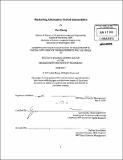| dc.contributor.advisor | Glen Urban. | en_US |
| dc.contributor.author | Zheng, Alex (Yi Alexis) | en_US |
| dc.contributor.other | Sloan School of Management. | en_US |
| dc.date.accessioned | 2011-09-13T17:53:09Z | |
| dc.date.available | 2011-09-13T17:53:09Z | |
| dc.date.copyright | 2011 | en_US |
| dc.date.issued | 2011 | en_US |
| dc.identifier.uri | http://hdl.handle.net/1721.1/65791 | |
| dc.description | Thesis (M.B.A.)--Massachusetts Institute of Technology, Sloan School of Management, 2011. | en_US |
| dc.description | Cataloged from PDF version of thesis. | en_US |
| dc.description | Includes bibliographical references (p. 37-38). | en_US |
| dc.description.abstract | Marketing alternative fueled vehicles is a difficult challenge for automakers. The foundation of the market, the terms of competition, and the customer segments involved are still being defined. But automakers can draw lessons from other industries, previous examples, and recent launches of the Chevy Volt and Nissan Leaf to help guide them. Automakers can deploy new marketing tools to advance their understanding of the market, define the terms of competition, and listen in to their customers' needs. These new tools can help reduce the risk and uncertainty involved with launching new products like alternative fueled vehicles. This thesis explores the major issues in marketing alternative fueled automobiles in several major parts. First it will look at the major drivers of alternative fueled vehicles and historical examples such as the Prius. While the market continues to change with each year, some trends emerge as key to defining the future of the industry. Second, it will look at the current strategic environment for alternative fueled vehicles, including an exploration of the various fuel types and vehicle offerings. Third, it will offer lessons learned for manufacturers based on the case study work done with two automotive manufacturers on real-life launches of a plug-in hybrid and a hydrogen vehicle. Some classical marketing frameworks, such as the innovation cycle, are used to help understand current puzzles, and new tools, such as semantic/perceptual maps, are used to help understand how open questions might be resolved in the next few years. Finally, it will explore a novel modeling tool developed for assessing potential adoption rates for alternative fueled vehicles by looking at costs and profits from both the owners and automakers' perspective. | en_US |
| dc.description.statementofresponsibility | by Alex Zheng. | en_US |
| dc.format.extent | 38 p. | en_US |
| dc.language.iso | eng | en_US |
| dc.publisher | Massachusetts Institute of Technology | en_US |
| dc.rights | M.I.T. theses are protected by
copyright. They may be viewed from this source for any purpose, but
reproduction or distribution in any format is prohibited without written
permission. See provided URL for inquiries about permission. | en_US |
| dc.rights.uri | http://dspace.mit.edu/handle/1721.1/7582 | en_US |
| dc.subject | Sloan School of Management. | en_US |
| dc.title | Marketing alternative fueled automobiles | en_US |
| dc.type | Thesis | en_US |
| dc.description.degree | M.B.A. | en_US |
| dc.contributor.department | Sloan School of Management | |
| dc.identifier.oclc | 749902433 | en_US |
